Bench Honors Memory of Bob Sparks
WCLT installs memorial bench overlooking Sandra Pond [MORE]
|
WCLT Offers Two $1,000 Scholarships
A good reason for WHS seniors to write an Earth Day essay [MORE]
|
WCLT’s Annual Earth Awareness Event
Live owl program will be a hoot! [MORE]
|
Join WCLT’s 2013 Earth Day Clean-Up
Make a year’s worth of difference [MORE]
|
Can You Recognize the New Invasive Plant in Town?
A hands-on opportunity to see and pull up garlic mustard plants [MORE]
|
Seashell Talk Featured Shells of Sandy Beaches and Rocky Shores
Summer at the beach came vividly to mind on a snowy Sunday in February [MORE]
|
Tracking Walk Found Wild Turkey Tracks at Wile Forest
Signs of the wild (and not-so-wild) were found during this January walk [MORE]
|
Walkers Discovered Westborough’s Geology
Geologist Andy Koenigsberg discussed glacial features around Mill Pond [MORE]
|
Many Mushrooms Grow in Westborough’s Woods
Field guide author to lead another mushroom walk in Westborough next fall [MORE]
|
American Chestnut Plantings Last Fall & This Spring
Reintroducing blight-resistant American chestnut trees into Westborough’s forests [MORE]
|
Partnership with Regional Watershed Organization
WCLT thanks NepRWA for help with purple loosestrife biocontrol project [MORE]
|
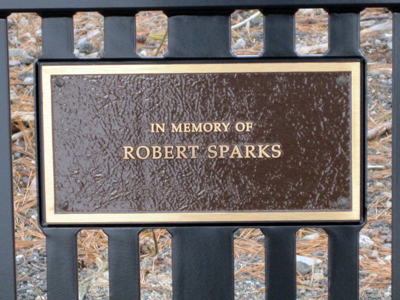
The Westborough Community Land Trust (WCLT) is pleased to announce the installation of a bench overlooking the Sandra Pond Reservoir in memory of Robert “Bob” Sparks, who lived nearby on Bowman Street and left a generous bequest to the land trust upon his death in 2010 at age 86.
Skip Ashton, WCLT member and a long-time close friend of Bob Sparks, spearheaded the bench project and worked with the Town Department of Public Works to get the bench installed.
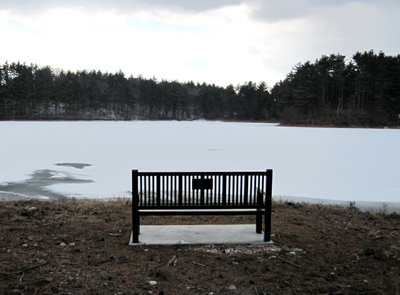
The memorial bench enables Westborough residents to enjoy the quiet beauty of the reservoir and the views over the water that Bob so loved. The bench is nicely situated between a tall white pine and a tall red pine on the northeastern shore of the reservoir, facing west and looking back at Bob’s former residence. The bench is visible from Bowman Street and is only a short walk from the street.
People who walk the Charm Bracelet trail from Minuteman Park on Upton Road to the Bowman Conservation Area parking lot off Bowman Street lot will pass near the bench in the early part of their walk.
Bob knew and loved nature and the wild places and open spaces of Westborough. He served the town on the Open Space Preservation Committee, Finance Committee, and other committees. His passing is Westborough’s loss. WCLT is pleased to honor his memory with a memorial bench that town residents can enjoy for many years to come.
“Bob Sparks spent decades walking and cross country skiing the trails in Westborough,” Skip noted. “He loved the open space we have and was dedicated to helping to preserve it and making sure people could enjoy it. His gift to WCLT was a reflection of his deep respect for the organization and support for its efforts.
“I call on people to make donations to assist in funding this bench that WCLT has installed in memory of Bob but also to support further protection of open space and expansion of trails. Let us honor the memory of Bob Sparks by assisting in his legacy to the land trust.”
WCLT president John Metzger commented, “WCLT is honored that Bob Sparks entrusted a substantial bequest to our care and we are actively looking for ways to use it to help to further the WCLT mission of preserving and stewarding open space in Westborough.”
For a map of the trails surrounding the Sandra Pond Reservoir, click here to download and print a trail map of the Bowman Conservation Area from the WCLT web site.
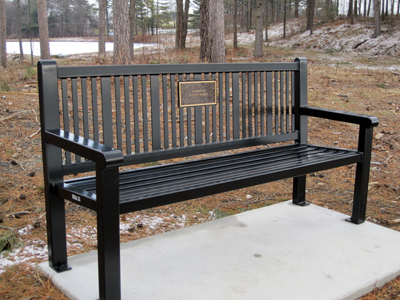
Back to top
|
|
A good reason for WHS seniors to write an Earth Day essay
For the second year in a row, the Westborough Community Land Trust (WCLT) is offering two scholarships of $1,000 each to the winners of its annual Earth Day Essay Contest, which runs in March for Westborough High School seniors.
Applicants must submit their Earth Day essays to the WHS Guidance Office by Monday, April 1, 2013. The scholarship forms and essay contest details are available in the WHS Guidance Office as of March 1, 2013. Scholarships are awarded at graduation.
Essays should be 500–750 words and should address one of these three topics:
- An environmental issue in Westborough
Describe an environmental issue that affects a natural resource in Westborough. Propose a solution that would address this issue and/or describe activities in which you have been involved that have worked towards solving this particular problem.
- Sustainable living in Westborough and beyond
Discuss ways that you and others of your generation could live more sustainably on Earth. If applicable, include a description of changes you have made in your own life that have enabled you or your family to live more sustainably.
- Protection of Westborough’s natural heritage and special places
Describe a place in Westborough that you think is especially important to protect, and explain why. Discuss what you have done or propose ways that you could help to protect Westborough’s natural heritage.
“Today’s high school seniors are the environmentalists of tomorrow,” says Annie Reid of the WCLT scholarship committee. “The Earth Day Essay Contest is a way for us to invite these young people to talk and write about the natural environment and express their feelings and concerns about it.”
Please support this effort by your land trust by spreading word of the essay contest and expanded scholarship program to your friends and neighbors.
Back to top
|
|
Live owl program will be a hoot
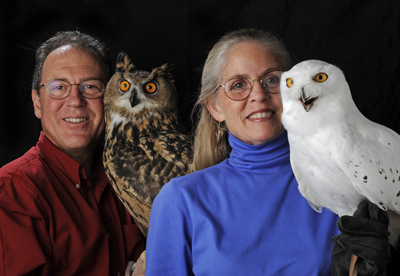
Mark and Marcia Wilson with two of their owls
Photo courtesy of Mark Wilson/Eyes On Owls
Everyone loves owls! New England’s live owls take center stage this spring as your land trust brings to Westborough the program “Who’s Watching You?” presented by naturalists Marcia and Mark Wilson of Eyes on Owls on Saturday, March 23. This Earth Awareness event begins at 10 a.m. at the Knights of Columbus Hall, 17 Willow Street, in Westborough.
The Westborough Community Land Trust’s (WCLT) yearly live animal program has become a rite of spring in town, providing a Saturday morning filled with exciting entertainment and nature knowledge for children and adults of all ages. As usual, the event is free, but donations are welcome. This year’s owl program is supported in part by a grant from the Westborough Cultural Council, a local agency which is supported by the Massachusetts Cultural Council, a state agency.
The program will feature six live owls and a hooting lesson for the audience. The owls on display are likely to include New England’s tiniest owl, the 4-ounce northern saw-whet owl, and the world’s largest owl, the Eurasian eagle owl, with a five-foot wingspan. Other owls that might make an appearance are the eastern screech owl, barred owl, barn owl, great horned owl, snowy owl, and spectacled owl.
Naturalists Marcia and Mark Wilson will also discuss owl habitats, field markings, signs such as owl pellets and whitewash, and behaviors. They plan to offer tips about ways to attract and protect owls.
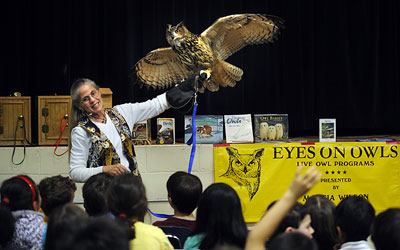
Photo courtesy of Mark Wilson/Eyes On Owls
According to the Wilsons, the great horned, barred, and eastern screech owls are the most common of the 12 owl species in New England. Boreal owls and great gray owls are rare here but are found on other continents. Others such as snowy owls and barn owls often feature in popular movies and nature programs.
Mark and Marcia Wilson founded Eyes on Owls in 1994 as an educational enterprise to use owls to introduce children to the wonders of wildlife and to build appreciation of the natural world. Since then they have traveled across New England to schools, libraries, and nature centers to share their knowledge and passion for owls.
All of the owls in their care are permanently disabled and would not survive on their own if returned to the wild. Many were injured when they were hit by cars. The Wilsons have special federal and state permits to display these owls for education. These owls are wild animals, not pets.
The Wilsons note that owls are specially adapted for living in diverse environments, from marshes to tundra and from rainforest to grasslands. Owls are found on all the continents except Antarctica. In these environments, owls are excellent hunters and thrive on eating small rodents like mice and voles. Some owls take insects, ducks, snakes, fish, frogs, bats, or even skunks.
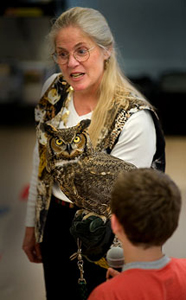 Photo courtesy of Mark Wilson/Eyes On Owls
Photo courtesy of Mark Wilson/Eyes On Owls
Marcia and Mark Wilson, both biology majors, have backgrounds rich in natural history. Marcia has more than 45 years of experience with natural history and field ornithology. As a child she was entranced by the bird banding and rehabilitation done by her parents. She later worked for Massachusetts Audubon Society in public education and conservation. On Nantucket, Marcia served 12 years as shorebird biologist, working with the Trustees of Reservations to protect the rare piping plovers, least terns, and American oystercatchers. She also designed and implemented the first natural history tour program on the Trustees' barrier beach refuge. For nine years she reported her observations in Nantucket’s weekly newspaper column, “Island Bird Sightings.”
Mark Wilson is a wildlife photographer, photojournalist, author, and avid birder. He was a staff photographer for 23 years at The Boston Globe, where he wrote “The Backyard Birder” column. His photos have appeared in many publications, including a National Geographic cover. A birder and outdoorsman since childhood, Mark combines a love of natural history with his photography, writing, and lecturing. His skill in interpreting both animal behavior and light brings a special dimension to his photographs and educational programs. Mark has traveled widely across North America from Alaska to Florida and from the Arctic to Australia to study and photograph birds, wildlife, and ecosystems. Most recently Mark was contributing author and photographer for the book Arctic Wings: Birds of the Arctic National Wildlife Refuge.
Don’t miss the Wilsons’ captivating, interactive program with live owls and wildlife photography on March 23.
Back to top
|
|
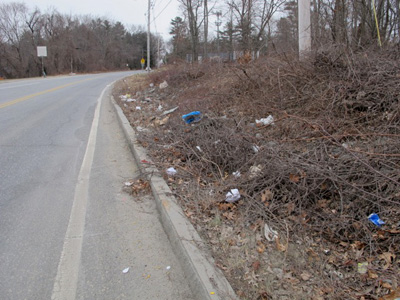
Let’s get rid of litter along our streets, such as this trash seen at Routes 9 and 30 before the blizzard of 2013.
“It’s all about taking pride in the town and doing something together that will show real and immediate results!”
So says Bruce Tretter, who is once again organizing WCLT’s annual town-wide Earth Day clean-up, an Earth Day event that the Westborough Community Land Trust has sponsored since its founding in 1997.
Make a difference in the way Westborough looks after a long winter by taking part in the clean-up on Saturday, April 20. Or if that day is not convenient, choose another time to pick up litter along streets and sidewalks in your neighborhood or elsewhere in town. Get friends, neighbors, or co-workers to join you or set out on their own.
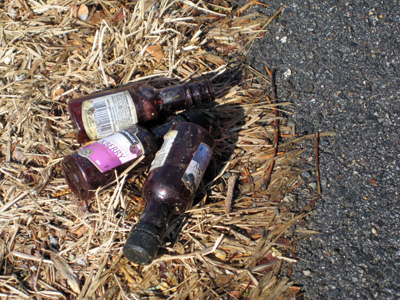
Let’s clear away litter along our sidewalks, such as these small “nip” bottles that have been tossed along sidewalks in a downtown neighborhood.
“The goal this year is to increase individual, family, and business participation,” Bruce noted.
Bruce is busy scouting out locations that need cleaning up as he bikes around town. He also welcomes suggestions from people who notice messy spots around town. Contact him by email at earthday@westboroughlandtrust.org.
As usual, on April 20, early risers can meet at 6:30 a.m. at either West Meadow Plaza or Bellows Road to start the pick-up. Families are invited at 9:30 a.m. to come to the Lake Chauncy parking lot to be assigned a site to clean up.
Trash bags will be provided. Wear gloves, long sleeves, and sturdy shoes.
Back to top
|
|
A hands-on opportunity to see and pull up garlic mustard plants
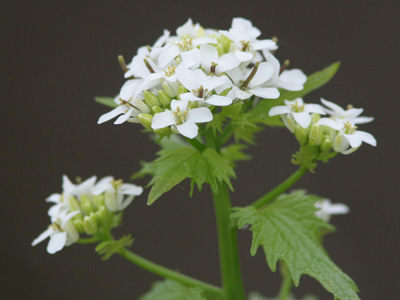
Garlic mustard has clusters of small white flowers with four petals. The leaves are triangular or kidney-shaped with large teeth.
Photo courtesy of Garry Kessler
Spring is coming, but with this wonderful season come invasive plants, which often green up before our native vegetation does. Would you like to protect our open spaces and your own property and neighborhood by learning about and helping to stop an invasive plant that is relatively new to Westborough? If so, plan to attend WCLT’s garlic mustard pull, on Sunday afternoon, April 28, 1:30–3 p.m. at the Bowman Conservation Area parking lot. Even if you haven’t seen it yet, you may have heard about garlic mustard (Alliaria petiolata). This new invader smells and tastes like garlic but belongs to the mustard family.
May and June are the months when garlic mustard is easy to spot. At that time of year, the weedy plants grow rapidly to 1½ to 3 feet tall, bloom with small four-petaled white flowers, go to seed, and die.
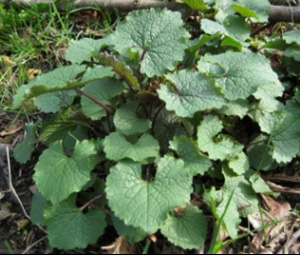
The plants actually live for two years. Garlic mustard is a biennial. In their first year, the plants grow as rosettes, which are circular clusters of leaves that lie close to the ground. First-year plants would be hard to spot at this stage, except for the fact that their leaves often stay green throughout the winter. This helps the plants get an early start in their second year. Green leaves in winter and early spring are unusual around here, so they might catch your attention.
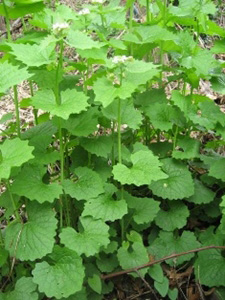
In their second year, garlic mustard plants quickly grow 1½ to 3 feet tall in May-June.
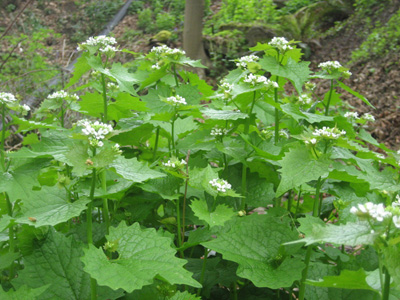
Garlic mustard plants in bloom, topped with clusters of small, white, four-petaled flowers.
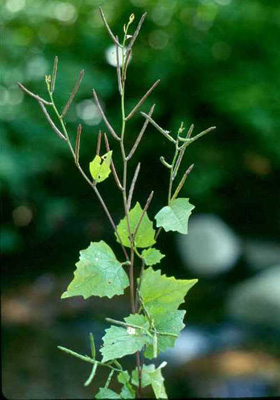
In June of their second year, garlic mustard plants bear many long, straight seedpods and then die.
The best way to stop an invasion is to nip it in the bud, so to speak, by removing the plants when the first small numbers of them begin to arrive. Many of us are not prepared to do that because garlic mustard is new to town and we haven’t yet learned to recognize it.
What makes garlic mustard so invasive? One reason is that garlic mustard produces large numbers of long-lasting seeds. It can self-pollinate, so a lone plant in a new area can produce seeds whether others are nearby or not. And when a single plant goes to seed in its second year, it produces thousands of seeds—up to 8,000. These seeds can survive 10–12 years in the soil. For more than a decade after the original plant is gone, new invaders can spring up from the “seed bank” left in the soil.
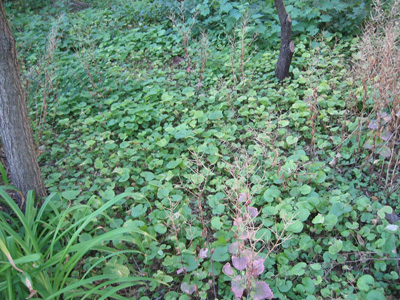
Carpet of garlic mustard rosettes
Photo © Donald and Benia Zouras
There’s another reason why garlic mustard grows profusely and spreads rapidly in North America, but not in Europe and Asia where it comes from. Here garlic mustard is free of the competing plants and natural enemies that keep it in check in its own native environment. In Europe, for example, it grows in patches but doesn't take over an area. There at least 30 different insects attack the plant. Not so here. Even our white-tailed deer won’t eat it. They don’t like the garlicky taste.
For more information about garlic mustard, read WCLT’s Nature Notes column, “A New Invasive in Town.” Originally published in the Westborough News in 2007, the column is now on the WCLT web site (click here).
If you come to WCLT’s garlic mustard pull, bring your gardening gloves. Wear long pants and long sleeves.
Back to top
|
|
Summer at the beach came vividly to mind and a snowy Sunday in February receded into the background for Westborough residents who attended the recent WCLT talk on seashells by biologist, natural history author, and WCLT director Scott Shumway. He focused on the creatures inside shells found on sandy ocean beaches and rocky ocean shores, which are within reach of summer travelers from Westborough.
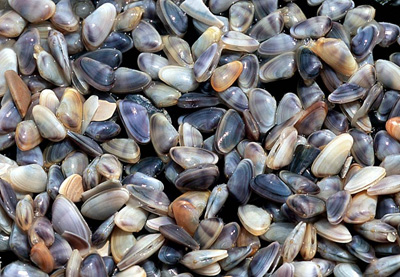
Tiny half-inch clams, called coquina or wedge clams, ride the waves and bury themselves in the sand as waves crash on the sandy beaches that are typical of Cape Cod and farther south. Scott also discussed quahogs, the clams whose shells were made into wampum by Native Americans; razor clams, with shells that resemble old-fashioned straight razors; and the increasingly common invasive European green crabs and Asian shore crabs.
Many of the shells that people find on beaches and rocky shores belong to various types of snails. The common periwinkle, which came from Europe, is now the most common snail in New England. The oyster drill preys on oysters in estuaries. The large moon snail feeds on the soft-shell clams that people enjoy eating as “steamers.”
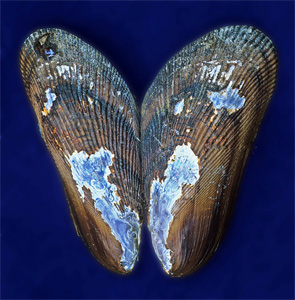
Mussels, which have shells like these, attach themselves to rocks and are common along the rocky ocean shores that are typical north of Cape Cod. Other creatures featured in Scott’s talk included scallops, which have two scalloped shells and can move themselves rapidly away from predators by squirting out jets of water with a kind of jet propulsion system; sea stars, which prey on clams, mussels, and oysters by using the suction cups on their “arms” to open them; barnacles; sea urchins, which include, surprisingly, sand dollars; horseshoe crabs with their armored bodies and copper-containing blue blood; and shorebirds such as laughing gulls and red knots which eat horseshoe crab eggs.
If you missed this talk and would like to find out what you can see on New England’s sandy beaches and rocky shores and elsewhere—in estuaries, tidal flats, salt marshes, and even the open ocean—check out Scott’s recent book, A Naturalist’s Guide to the Atlantic Seashore. Scott Shumway is Jennings Professor of Biology at Wheaton College.
Back to top
|
|
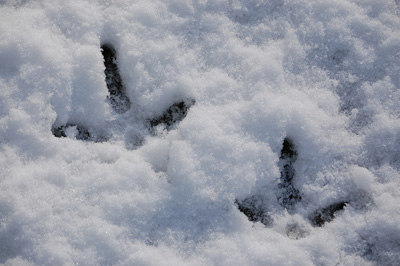
Wild turkey tracks
Even though there was very little snow on the ground for tracking at the time, WCLT’s tracking walk took place at Wile Forest on Sunday afternoon, January 20. Naturalist Ann Marie Pilch, who is education director for Tower Hill Botanic Garden, led the walk. The group spotted wild turkey tracks, deer trails, and signs of red squirrels feeding on pine cones. Ann Marie guided the group in observing the bark and form of trees in the forest, including red and white oaks, American beech, and witch hazel.
The group also noted evidence of past human use of the property, which included farming and later on, logging. Reminders of these uses included old stone walls, an old woods road, many trees with double trunks (or more) sprouted from stumps left by past logging, and trees with healed-over gashes and wounds probably made years ago when log-transporting equipment bumped these trees.
If you’d like to explore Wile Forest, owned by the New England Forestry Foundation (NEFF), or the adjacent Libbey Conservation Area, owned by the Town of Westborough, click here to check the WCLT web site for a trail map to download and print out.
The map pamphlet also contains a description of the property, recommended walks, and driving directions.
Back to top
|
|
Geologist Andy Koenigsberg pointed out glacial striations—grooves carved in rock by a glacier—near Mill Pond in Veterans’ Freedom Park during a geology walk he led for WCLT last fall along the Charm Bracelet trail from the park to the Headwaters Conservation Area (HCA). The group learned about features of Westborough’s landscape left by glaciers, including glacial erratics—large boulders dropped by a glacier—and eskers—narrow ridges formed from deposits left by a river running inside a glacier.
Hikers headed downhill in Veterans’ Freedom Park toward Mill Pond at the beginning of last fall’s geology walk led by Andy Koenigsberg. The group followed the Malley Trail to the pump house near the HCA’s Andrews Street entrance and back again. Andy discussed Westborough’s water supply and the sand and gravel aquifer tapped by town wells in the vicinity of Mill Pond. The sand and gravel were deposited as outwash from a melting glacier. If you’d like to walk the area yourself, click here to get a trail map of the Mill Pond area.
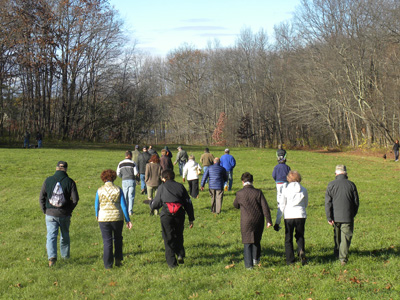
Back to top
|
|
Field guide author to lead another mushroom walk in Westborough next fall
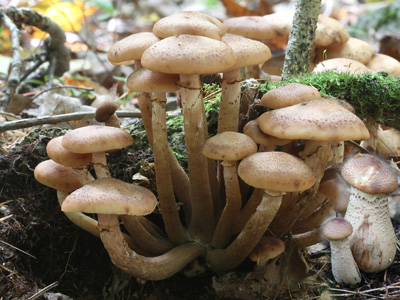
Honey mushrooms (Armillaria mellea), which grow as parasites on hardwood trees and their roots, were among the many mushroom species found in Westborough’s woods during Larry Millman’s fall 2012 mushroom walk at the Headwaters Conservation Area (HCA).
Photo courtesy of Garry Kessler
Did you miss last fall’s WCLT mushroom walk with mycologist Larry Millman, who pointed out more than 50 species of mushrooms and other fungi at the Headwaters Conservation Area (HCA) behind Mill Pond School last September? If so, you’ll have another chance to learn about the many mushrooms in Westborough’s woods when Larry returns to Westborough to lead another mushroom walk for WCLT in fall 2013.
Next time he’ll lead a group in checking out mushrooms at Wile Forest and Libbey Conservation Area. The walk will take place a little later in the season, in late October, on Sunday, October 27. There will be new species to see because the location and time of year will be different. As usual, Larry will focus on mushroom ecology and mushroom identification rather than on edibility. If you’re interested, note the date on your calendar now, because Larry’s walks are limited to 18 people. (Sign-up will take place in the fall.)
Larry Millman is the author of Fascinating Fungi of New England, the recently published guidebook to the fungi we’re most likely to see in New England.
To find out what mushrooms he found on last fall’s walk, click here to read WCLT’s Nature Notes column, “Hunting for Mushrooms with an Expert,” originally published in the Westborough News, on the WCLT web site.
Click here for a trail map of the Headwaters Conservation Area, where the 2012 walk took place.
Click here for a trail map of Wile Forest and Libbey Conservation Area, where the upcoming fall 2013 walk will take place.
Back to top
|
|
Reintroducing blight-resistant American chestnut trees into Westborough’s forests

Photo courtesy of Garry Kessler
Several WCLT members were among the Westborough residents who turned out last November to help plant American chestnut seeds (nuts) at the town’s Bowman Conservation Area surrounding the Sandra Pond Reservoir, in an activity organized by the American Chestnut Foundation (ACF, www.acf.org) and the Westborough Conservation Commission. A second such planting is planned for this spring.
American chestnut trees were once the dominant trees in Massachusetts forests and beyond, but they were wiped out by the chestnut blight, a fungus that arrived from Asia around 1900 and spread across North America, killing almost all mature chestnut trees by 1940. The American Chestnut Foundation has done research and undertaken a program to breed blight-resistant trees by crossing American chestnuts with blight-resistant Chinese chestnut trees. The nuts planted in Westborough are a product of that program.
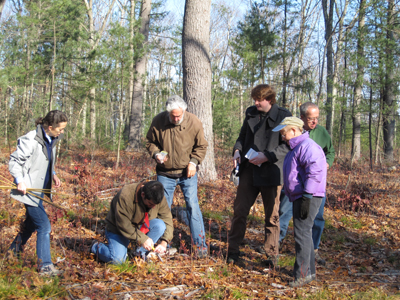
The goal of the chestnut planting in Westborough is to raise a new generation of American chestnut trees from seed, determine their blight-resistance, and reintroduce blight-resistant American chestnut trees back into Westborough’s forests. Two plots at the Bowman Conservation Area were planted with nuts.
As an experiment, half of the nuts planted had been treated with hot pepper sauce to see if it would discourage mice and squirrels from digging them up and eating them. If significantly more seedlings come up from treated nuts than from untreated nuts, that result would suggest that the treatment works.
For a map of the trails surrounding the Sandra Pond Reservoir, click here to download and print a trail map of the Bowman Conservation Area from the WCLT web site.
Back to top
|
|
WCLT thanks NepRWA for help with purple loosestrife biocontrol project

Volunteers from NepRWA and WCLT (Janet Anderson and Annie Reid shown) await the arrival of chilled Galerucella beetles at the NepRWA headquarters in Canton, MA. Volunteers introduced the beetles onto potted, net-covered purple loosestrife plants, where the beetles reproduced and yielded a new, much larger generation of beetles that were then released in local wetlands containing invasive purple loosestrife.
The Westborough Community Land Trust (WCLT) thanks the Neponset River Watershed Association (NepRWA), based in Canton, MA, for its help over the past four years in preparing us to carry out our purple loosestrife biocontrol project, now in its fifth year. We are especially grateful to NepRWA’s outreach director and restoration manager, Carly Rocklen, who personally provided this help.
Specifically, NepRWA ran its own large-scale purple loosestrife biocontrol project in the Neponset River watershed, involving 50 volunteers, and kindly opened its training sessions for its own volunteers to WCLT. Our volunteers learned from them about “beetle ranching”—how to raise and release the Galerucella biocontrol beetles that eat invasive purple loosestrife—and about standard monitoring techniques.
NepRWA also enabled WCLT to obtain “starter beetles” each spring by including our yearly orders for a small number of beetles with their own much larger beetle orders. In return, we helped with some related tasks, such as dividing up shipments of thousands of chilled Galerucella beetles and placing them into hundreds of plastic cups containing 15–20 each.
In addition, each season Carly kept us up-to-date about issues, supplies, techniques, problems, and solutions through her informative and good-humored emails.
We thank NepRWA for this productive partnership. Thanks to their support, we have been able to carry out our purple loosestrife biocontrol project, an educational and environmental project which gave Westborough High School students an opportunity to do environmental work and improved the quality of Westborough’s natural environment.
Back to top
|
|
|